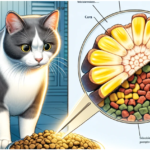Arthritis doesn’t just affect people; our feline friends can feel those joint aches too, especially as they get older. But because cats are so good at hiding discomfort, we often miss the subtle signs. Let’s walk through what feline arthritis is, how to spot it, and what you can do to help your kitty stay comfortable and active.
What Exactly is Feline Arthritis?
Think of feline arthritis as a kind of “wear and tear” on the joints. Over time, the smooth cartilage between the bones wears down, making movement more uncomfortable. For cats, this usually shows up in places like their hips, knees, elbows, and even the spine.
Why Do Cats Get Arthritis?
A few different factors can contribute to arthritis in cats:
- Age: Just like us, cats face natural wear and tear as they age.
- Previous Injuries: If your cat has had a broken bone or a serious sprain in the past, that joint is more prone to arthritis down the road.
- Genetics: Some breeds, like Maine Coons and Persians, are more likely to develop joint issues.
- Extra Weight: Carrying around extra pounds puts extra stress on those little joints.
Spotting the Signs: Recognizing Arthritis Symptoms in Cats
Cats can be mysterious little creatures, and they’re pros at hiding pain. But if you know what to look for, you might catch those early signs of arthritis:
- Less Jumping or Climbing: Is your cat avoiding their favorite high perches? It might be because it hurts to jump.
- Walking with a Limp or Stiffness: They might start moving more slowly or limp a little, especially after a nap.
- Skipping Grooming: If grooming is painful, they might not keep up with it, leading to a bit of a “bedhead” look.
- More Napping: Arthritis can make moving tiring, so don’t be surprised if they seem sleepier than usual.
- Trouble with the Litter Box: High-sided boxes can be a challenge for cats with sore joints, leading to accidents nearby.
- Acting Grumpier: Cats in pain might be a little more irritable or withdrawn—just their way of saying they’re not feeling great.
How Vets Diagnose Arthritis
If you suspect your cat might have arthritis, a vet visit is a good idea. Your vet will likely check their gait and feel around the joints for any pain or stiffness. Sometimes, they might recommend X-rays or other imaging to see what’s going on inside those achy joints.
Treatment Options for Feline Arthritis
There’s no magic cure for arthritis, but there are lots of ways to manage it and help your cat feel more comfortable:
- Pain Relief Medications: Vets may prescribe non-steroidal anti-inflammatory drugs (NSAIDs) or other pain relievers, though always with caution, as cats can be sensitive to medication.
- Joint Supplements: Supplements like glucosamine and chondroitin may help with cartilage health.
- Gentle Physical Therapy: Light stretching, massages, or even acupuncture can help with flexibility and pain relief.
- Keeping the Pounds Off: If your cat is on the chubby side, helping them lose a bit can lighten the load on their joints.
- Making Home Cozy: Adding ramps, low-sided litter boxes, and cushy beds can make life easier and more comfortable.
- Alternative Treatments: Laser therapy and acupuncture are becoming popular for pain management and reducing inflammation.
Making Home Arthritis-Friendly
Adjusting your home can make a big difference for a cat with arthritis. Here are some easy changes:
- Lower Litter Boxes: Opt for low-sided boxes so they can step in without any trouble.
- Cozy, Warm Beds: Heat can be soothing, so consider a heated bed or blanket for your cat.
- Ramps and Steps: Placing ramps by their favorite spots, like the bed or couch, can save them a painful jump.
Can You Prevent Arthritis?
While we can’t completely prevent arthritis, there are a few ways to help your cat’s joints stay healthier longer:
- Keep Them Active: Play sessions keep muscles strong, which helps support the joints.
- Healthy Diet: Maintaining a healthy weight reduces pressure on their joints.
- Routine Vet Checkups: Regular vet visits can catch early signs of arthritis, making it easier to treat.
Additional Resources
If you want to dive deeper into feline arthritis or find more support, these expert resources are a fantastic place to start:
- American College of Veterinary Surgeons (ACVS): They offer great info on feline joint conditions and treatments.
- Cornell Feline Health Center: Cornell’s website has tons of articles about cat health, including arthritis.
- American Association of Feline Practitioners (AAFP): They provide resources specifically geared toward managing chronic pain in cats.
- International Cat Care: With a global perspective, they offer resources for managing arthritis and other chronic conditions in cats.






